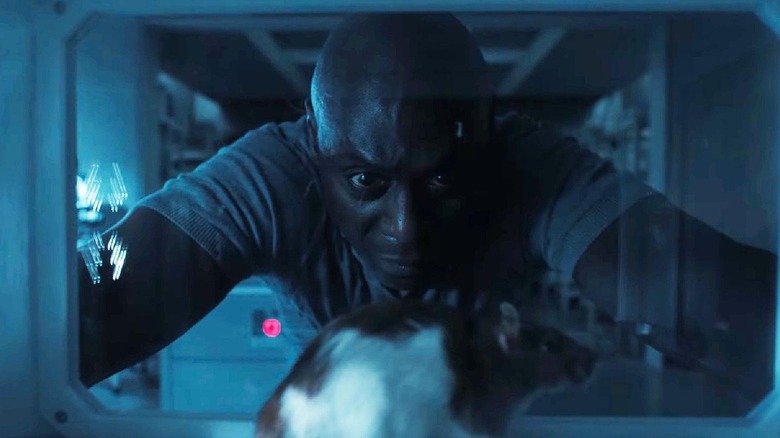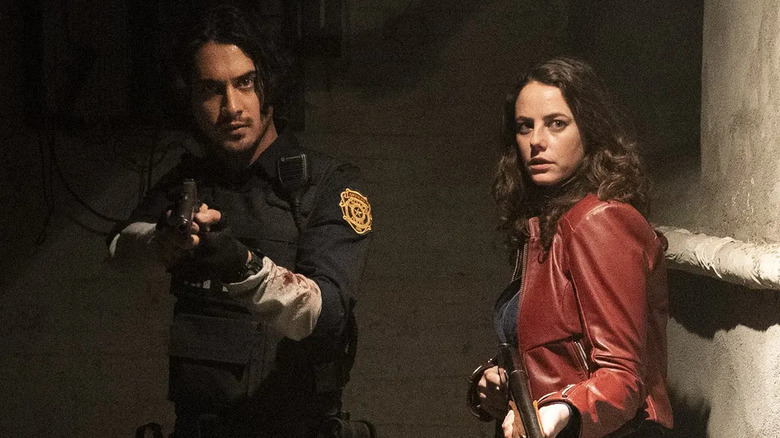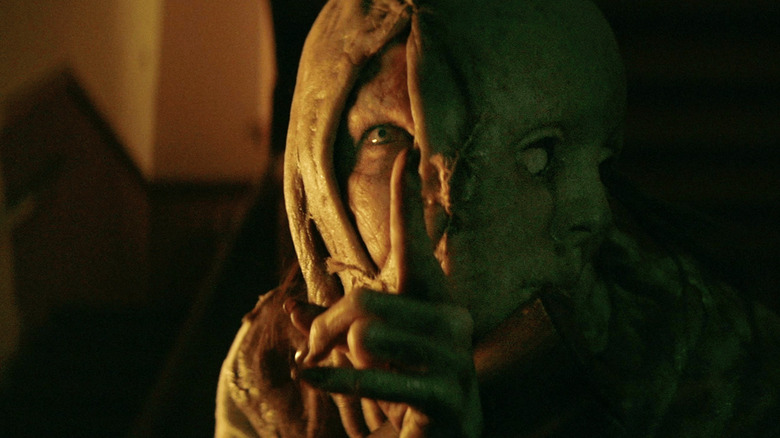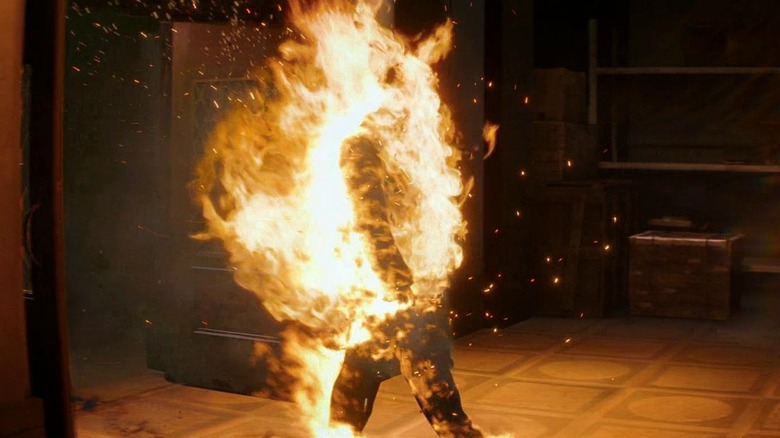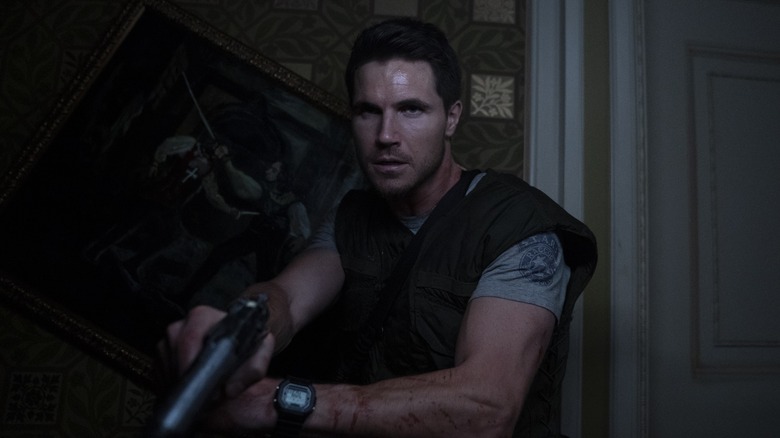Why Resident Evil: Welcome To Raccoon City Flopped
Umbrellaisjoy.com looks like any other modern health website. It's slick, brightly colored, and filled with photos of happy, healthy humans. It's appealing in a bland, accessible way. Stay on umbrellaisjoy.com for more than 20 seconds, however, and the site evolves into a digital nightmare. It becomes sickly-hued and blood-spattered. Its centerpiece is one of two new trailers for Netflix's new "Resident Evil" series starring Lance Reddick, Siena Agudong, and Tamara Smart, premiering in the summer of 2022.
This polished trailer drop is a far cry from the speedy, sudden rollout for 2021's "Resident Evil: Welcome To Raccoon City." Director Johannes Roberts' ("47 Meters Down: Uncaged," "The Strangers: Prey At Night") soft relaunch of the film series based on Capcom's massively successful horror video game series is something of a head-scratcher. It made more than $40 million domestically against a reported $25 million budget. It did so when the Omicron variant of COVID made movie theater attendance stagnant. Seven months after its release, a new reboot has taken its place. Why?
This is the quandary of "Resident Evil: Welcome To Raccoon City," a film that connected enough with audiences to be successful at a time when most films weren't but didn't win over many hearts in the process. "Raccoon City" is a strange, mercurial beast that offers an alternative blueprint for the video-game movie — and one that the "Resident Evil" Netflix show looks ready to refute with haste.
Here's why "Resident Evil: Welcome To Raccoon City" flopped.
Director Johannes Roberts
Many artists are misunderstood in their time. Johannes Roberts might be one of them. Roberts is best known for the direct-to-video horror sequel "The Strangers: Prey at Night" and both "47 Meters Down" films. The former is a film no one anticipated or asked for. 2008's "The Strangers" ends on a grim, definitive closing note, and the notion of spending more time with its home invaders doesn't carry the transgressive thrill of a new Jason or Michael Meyers movie. Yet, Roberts seized on the original's stark imagery and applied it to a more thrill-ride-ready narrative, adding in dashes of 1980s camera flair and a John Carpenter-like score. Of "The Strangers: Prey at Night," /Film's Candice Frederick said the film "conveys the triviality of terror," which is more fascinating praise than a layman audience might expect for an obscure horror sequel.
On the other hand, Roberts' "47 Meters Down" films have tremendous fun with shark horror movie conventions. A third act scene from "47 Meters Down: Uncaged," features a randomly screaming fish that outs the protagonist's whereabouts, and it's just as strange and funny as it sounds. All in all, Roberts's filmography looks like schlock on paper but is low-key wonderful in practice. His movies are smarter, gutsier, and more interesting than they seem at first glance.
As improbable as it seems, general audiences might not have gotten "Resident Evil: Welcome To Raccoon City."
Is Resident Evil: Welcome to Raccoon City good?
This begs the question: is "Resident Evil: Welcome To Raccoon City" good?
It depends on who you ask. The film received an aggregate score of 31% on Rotten Tomatoes with audiences on that site netting it a 65% approval rating. More interestingly, though, is the "C+" CinemaScore audiences gave the film on opening weekend. That's almost a full letter grade below the "B" CinemaScore that Paul W.S. Anderson's "Resident Evil" films routinely earned and a clear indication that "Raccoon City" didn't play as well with the general moviegoing public.
Anderson's films are action-horror efforts that are far more action-heavy than frightening. Roberts' "Raccoon City," on the other hand, leans into the scares that made Capcom's game series so memorable. As /Film's Chris Evangelista writes in his review, "There are occasional bursts of gunfire here, but "Raccoon City" is a horror movie first, action movie second. And maybe that'll be enough for hardcore fans of the game who felt screwed over by Anderson's films." The film also pulls directly from the "Resident Evil" games and their labyrinthine (and deeply silly) mythology. It's not just The Umbrella Corporation that receives lip service. Chris and Claire Redfield are the film's main characters. The orphanage, prominently featured in the "Resident Evil 2" game remake, is painstakingly recreated for "Raccoon City."
Roberts' film is in almost every way, a love letter to the video games that inspired it. That may be the main reason it flopped.
A video game adaptation... in every sense
The "Resident Evil" games are known for many sterling and strange elements. There's the iconic monster design. There's the ever-evolving lore that surrounds the Umbrella Corporation, a monolithic institution secretly practicing cutting-edge pharmaceutical experimentation and eugenics. Most memorable of all are its cut-scenes. At the time "Resident Evil" and "Resident Evil 2" were released, their in-game cinematic sequences were top of the line. They are so infamous that they were painstakingly remastered for the 2019 "Resident Evil 2" remake. That game opens with a truck driver listening to a radio broadcast in which a caller describes, a strange, corpselike woman. Distracted, the driver then runs over a girl who, shortly thereafter, proves to be a zombie.
This exact scene is woven into the opening of "Resident Evil: Welcome To Raccoon City," from its on-the-nose dialogue to its bleary, rain-soaked atmosphere. The rest of the film maintains that tone, one that's alternately cheesy, horrifying, and frighteningly funny. Roberts' film doesn't just adapt the story of "Resident Evil" video games. It translates the feeling of playing them to the big screen. Some of its stranger touches are more deliberate than they might appear at first glance like the noir-tinged bickering between the Redfield siblings and the sequence in which a truck explodes in front of the police station and a zombie emerges, engulfed in flames, to the sound of MC Vintage's "It's Just A Little Crush." These are features, and not bugs, of Roberts' movie. Most audiences didn't like that.
Misplaced expectations
A clear picture is beginning to form around "Resident Evil: Welcome To Raccoon City" and why it flopped. The film's eerie horror vibes were a shift from Paul W.S. Anderson's massively successful, action-oriented entries in the franchise. Audiences were unfamiliar with Johannes Roberts and his directorial idiosyncrasies. Ultimately, "Raccoon City" was a different film than was advertised.
Rewatching the "Raccoon City" trailer, the film's quirky sense of humor is presented through the use of 4 Non-Blondes "What's Up?." That said, it also leans so fully into the film's intermittent bursts of action that it would be easy for audiences to walk away disappointed by the final product. Audiences wanted a film that felt familiar and delivered on its promise — the massive success of "Spider-Man: No Way Home," released one month later, makes that abundantly apparent. That's not what "Raccoon City" offered. Despite a box-office haul that exceeded its budget, it has already all but vanished from the mainstream's memory. The new Netflix version makes this all too clear.
